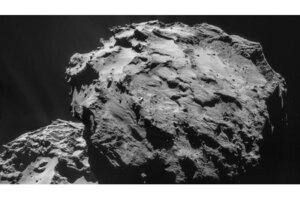Where did Earth's water come from? Rosetta data muddies picture.
Water vapor emitted by Comet 67P/Churyumov-Geramisenko is very different from the water found on Earth, casting doubt on the belief that Earth's water originally came from comets.

Four image NAVCAM mosaic of Comet 67P/Churyumov-Geramesinko, comprising images taken on 7 December 2014.
ESA/Rosetta/NAVCAM – CC BY-SA IGO 3.0
Sen—The first published results from the Rosetta space mission to a comet have thrown a spanner in the works for scientists trying to understand where Earth's water came from.
Vapour given off by Comet 67P/Churyumov-Geramisenko show that its water is very different in character from that covering our own planet.
A leading theory to explain the Earth's oceans has been that the water was delivered from space by heavy bombardment by comets in the distant past.
The key to where the water originated is the proportion of deuterium, a form of hydrogen with an additional neutron, to normal hydrogen. This proportion should change with distance from the Sun and with time in the first few million years.
To determine how much comets or asteroids may have contributed to Earth’s water, we need to compare the value for different kinds of object with that measured for Earth’s oceans.
Long-period comets from the Oort cloud originally formed in the Uranus–Neptune region, far enough from the Sun that water ice could survive. They were later scattered to the Solar System’s outer reaches as a result of gravitational interactions with the gas giant planets.
67P now travels around the Sun between the orbits of Earth and Mars at its closest and just beyond Jupiter at its furthest, with a period of about 6.5 years. Jupiter-family comets like 67P were thought to have formed in the Kuiper Belt beyond Neptune. Occasionally these bodies are disrupted from this location and sent towards the inner Solar System, where their orbits become controlled by the gravitational influence of Jupiter.
Deuterium/hydrogen (D/H) ratio in other comets have shown a wide range of values. Of the 11 comets for which measurements have been made, only the Jupiter-family Comet 103P/Hartley 2 was found to match the composition of Earth’s water. Meteorites from the Asteroid Belt also match the composition of Earth’s water.
Though asteroids have a lower water content, impacts by a large number of them could still result in Earth’s oceans.
The D/H ratio measured by the Rosetta Orbiter Spectrometer for Ion and Neutral Analysis (ROSINA) is greater than for Earth’s oceans and for its Jupiter-family companion, Comet Hartley 2 and even higher than for any Oort cloud comet.
UK comet expert Professor Alan Fitzsimmons, of Queen’s University Belfast, told Sen: “We need to wait for the results from the PTOLEMY experiment onboard Philae, but this result from ROSINA clearly implies that Kuiper belt comets may not have provided Earth's water. If this holds up, then it's time to look closer to home for the source of Earth's water, namely the outer asteroid belt and Main-Belt Comets.”
PTOLEMY is the evolved gas analyser, aboard Rosetta's Philae lander, which measures isotopic ratios of light elements. Main-belt comets are bodies that orbit within the asteroid belt that show comet-like activity during part of their orbit.
“This surprising finding could indicate a diverse origin for the Jupiter-family comets—perhaps they formed over a wider range of distances in the young Solar System than we previously thought,” says Kathrin Altwegg, principal investigator for ROSINA and lead author of the paper reporting the results in the journal Science.
“Our finding also rules out the idea that Jupiter-family comets contain solely Earth ocean-like water, and adds weight to models that place more emphasis on asteroids as the main delivery mechanism for Earth’s oceans.”
“We knew that Rosetta’s in situ analysis of this comet was always going to throw up surprises for the bigger picture of Solar System science, and this outstanding observation certainly adds fuel to the debate about the origin of Earth’s water,” says Matt Taylor, ESA’s Rosetta project scientist.
Related Links:
Philae finds life's building blocks on comet's surface
Philae experiment grabbed precious data before lander lost power
Rosetta team track Philae's spin and tumble after comet landing
Original story from Sen. © 2014 Sen TV Limited. All rights reserved. This material may not be published, broadcast, rewritten or redistributed. For more space news visit Sen.com and follow @sen on Twitter.

